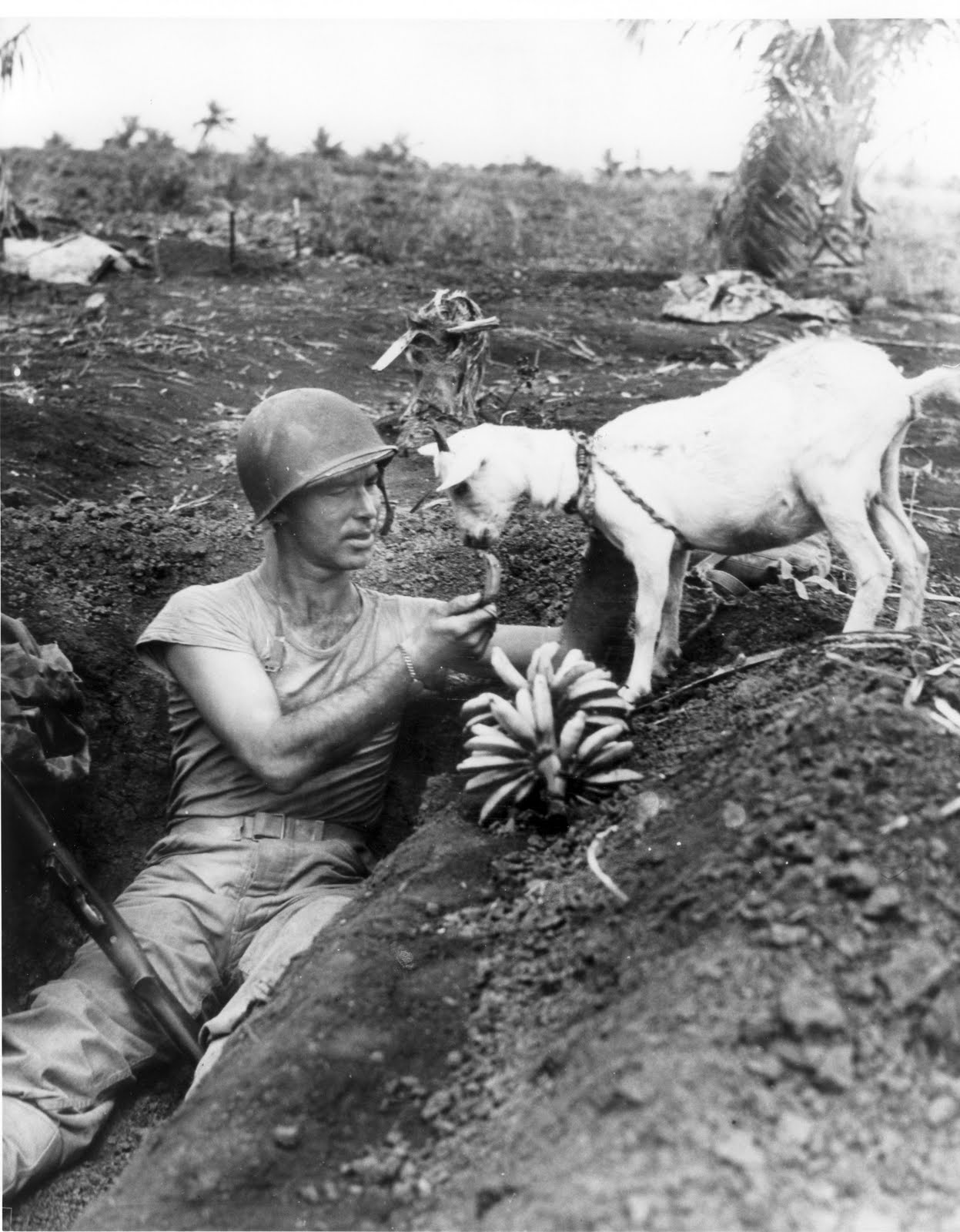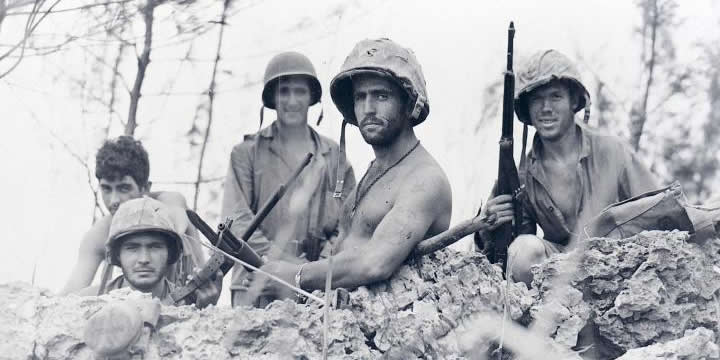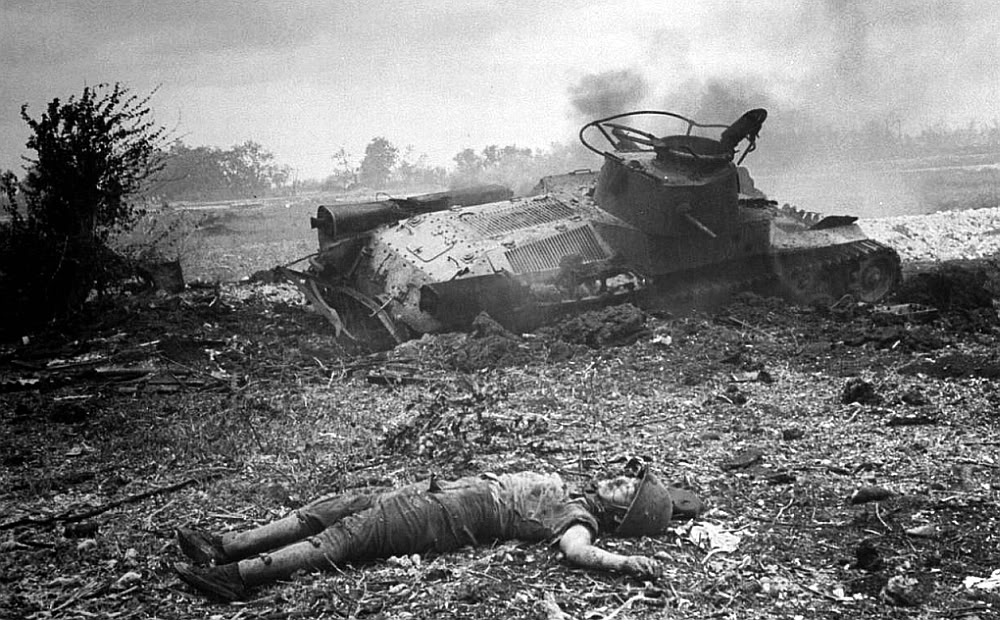| Battle for Saipan, Part Four
By David H. Lippman
March 2014
You can read Part Three here.
South of Afetna Point, the 4th Marine Division pushed forward, struggling to gain a large concrete ramp that would be a perfect landing spot for the 46 gleaming new M-4 Sherman tanks of the divisional tank battalion. The Shermans’ 75mm guns were superior to those of any Japanese machine, and the battalion included a platoon of specially-equipped flame tanks mounting Canadian Ronson flame guns that could spew a stream of fire up to 80 yards. The problem was getting the tanks ashore. Some of the tanks made it, but others never reached the shore – their landing craft were sunk on the run-in by Japanese guns.
 But if the tanks were having trouble coming ashore, 4th Marine Division’s artillery was in battery and ready to fire soon after the landing. Two battalions of 75mm pack howitzers and three of 105mm howitzers were landed and began a spectacular artillery duel with Japanese guns, which gave the division’s commander, Maj. Gen. Harry Schmidt, some relief. His command post was a foxhole 50 yards from the water, under heavy Japanese fire. He said later, “It was the hottest spot I was in during the war not even excepting Iwo Jima.” But if the tanks were having trouble coming ashore, 4th Marine Division’s artillery was in battery and ready to fire soon after the landing. Two battalions of 75mm pack howitzers and three of 105mm howitzers were landed and began a spectacular artillery duel with Japanese guns, which gave the division’s commander, Maj. Gen. Harry Schmidt, some relief. His command post was a foxhole 50 yards from the water, under heavy Japanese fire. He said later, “It was the hottest spot I was in during the war not even excepting Iwo Jima.”
Life was no easier for the Japanese defenders. Sgt. Yamauchi and his pals were holding their ground at 2 p.m., when a second lieutenant came up, the adjutant from battalion headquarters. He stood behind Yamauchi, and said, “Why don’t you charge?”
Yamauchi said he had received no orders to do so from his own platoon commander, so the adjutant yelled, “Everyone else has charged! I order you to charge!” Yamauchi didn’t see the point of doing so – his men would be mowed down – but he did see the samurai sword the lieutenant whipped out of his scabbard, and Yamauchi yelled to his men, “We will now attack the enemy position! Charge! Advance!”
Yamauchi charged immediately. Only two men joined him. “Bullets were ricocheting off the rocks in front of me. I fired at an American soldier who seemed practically on top of me. I suddenly felt something hot on my neck. Blood. I’m hit, I thought. But it was just a graze. I was too petrified to move,” Yamauchi recalled. “I couldn’t even shoot any more.”
Realizing his attack was doomed, he ordered his two buddies to withdraw, but both were hit, one dead, the other wounded in the face. Yamauchi ran back to his trench alone to find the adjutant nowhere to be found, the rest of his squad still dug in. “I asked the others why they hadn’t obeyed my order,” Yamauchi said later. “They just apologized.”
Yamauchi ordered the newly-married Pfc. Nakajima to stand watch. Bearded like American actor Ronald Colman, Nakajima had recently been married. As Yamauchi checked his men, he heard Nakajima call out. He’d been shot clean through in the arm. But as Yamauchi checked the wound, Nakajima yelled, “My stomach!” The bullet had carved through his guts and into his back.
By sunset, 20,000 Americans had gained a beachhead some 10,000 yards long and 1,000 yards deep, manned by most of the two divisions, supported by seven artillery battalions and most of two tank battalions. About half of the expected terrain had been taken, at the cost of several hundred American dead. “There is something definitely terrifying about the first night on a hostile beach,” Marine Lt. J.G. Lucas described the situation later. “No matter what superiority you may boast in men and materiel, on that first night you’re the underdog, and the enemy is in a position to make you pay through the nose.”

Saito was determined to do just that. As night fell, he radioed Tokyo, “After dark this division will launch a night attack in force and expect to annihilate the enemy at one swoop.” He was confident, but his men weren’t: they were sending in only 36 T-97 tanks and 1,000 infantrymen of the 136th Infantry Regiment against the Marines, under Major Tirashi Hirakushi, a former public relations officer. Someone brought up the regimental colors to inspire the men. Yamauchi and his battered squad were told to hold the trenches while the rest of the men attacked.
Chaos reigned from the beginning. Saito was to give the attack force a personal send-off from a hill above Charan Kanoa. American artillery observers saw all the movement to the assembly point and treated it to a dose of high explosive fire, scattering the general’s staff. Everyone waited around for the general to show up, but word trickled down that Saito had been killed, burned to death in a sugar-cane fire. Hirakushi was relieved of his job of leading the attack and ordered to find the general, or at least his body. Another officer was assigned to head the attack at the last minute, which weakened unit cohesion.
The new boss mounted the lead tank, and ordered his men forward. Before the tank had gone half a mile, an American shell disabled it. The remaining tanks clanked ahead without waiting for the infantrymen, making them sitting targets for American guns, but shells didn’t do them in – most of them were bogged down in a swamp east of town. The remaining tanks lumbered on, pursued by panting infantry and officers brandishing samurai swords. Yamauchi heard his pals shuffling forward, and fell asleep from exhaustion. The Americans were only 100 meters away.
With their usual ferocity, the Japanese infantry charged into the Marine defenses. As they lurched forward, the Marines lit up the sky with flares and .50-caliber machine-gun fire, waking up Yamauchi. The 6th Marines had heard the Japanese boots, tanks, clattering swords, and finally their bugles blaring battle calls.
As the American machine guns ripped into the Japanese attack, their forward observers radioed Navy destroyers standing offshore to hurl final protective fire against the enemy. Japanese tanks emerged from the dark, lit up by flares and machine-gun tracer, and American Sherman tanks roared into action. The American tanks and their 75mm guns were inferior to their German opponents in Europe, but far superior to the Japanese T-97 and its 47mm gun, and began ripping open the riveted Japanese tank hulls. Amid the noise and gunfire, the battleship California added to the destruction with her massive shells. More than 700 Japanese soldiers died without gaining any ground.

Japanese naval troops of the 1st Yokusuka Special Naval Landing Force under Nagumo’s command joined the fight, trying to support the attack on the northern flank, and arrived just in time to see the Army men retreating. Mistaking the Army troops for Americans, the Japanese Navy men opened fire on the Army, and the Japanese had a brief intramural skirmish.
In their trenches and “spider holes,” Yamauchi and his squad watched the battle in amazement, and saw their defeated comrades retreating through their positions. Someone asked Yamauchi what they should do if the Americans counterattacked. “Here’s where I want to be captured,” Yamauchi thought. “In order to survive, I will become a prisoner.”
But Yamauchi was unable to answer his men, so they withdrew. Yamauchi decided he would play dead, lying face down in his trench. He’d heard the Americans shot up Japanese corpses, but was willing to take a chance, to survive the battle. Still exhausted, he again fell asleep in his trench, and was kicked awake in the morning by a Japanese soldier, one of a group that was trying to retreat through his trench, but were blocked by his body. With the other guys, Yamauchi crawled off, dropping his rifle and ammunition case – with its more than 100 bullets – trying to flee the Americans.
Meanwhile, Hirakushi had spent the night trying to find Saito’s body in the cane field. Incendiary shells created raging fires, and Hirakushi had to cut down the cane with his samurai sword to create a path through the field, using it as a scythe. He finally reached the division tactical HQ before dawn, and found Saito sitting outside the cave, chin on chest.
“Are you all right, Division Commander?” Hirakushi asked. Saito looked up but made no response.
Up on Mount Donnay, Shizuko Miura held a flashlight in the dark as medics worked their way down the long line of patients. It was easier for doctors and medics to remove shrapnel from wounded men after they’d passed out. After that, she dressed wounds, and helped doctors perform amputations. The Japanese doctors were short of anesthetics and bandages, and had to re-use the latter.
On the southern flank, the Japanese hurled a strong attack, backed by artillery and mortars, against the 25th Marines. The Japanese used civilians, including women and children, to mask their approach, and the Americans at first thought this was a civilian surrender. But when they neared the American lines, the Marines saw through the ruse and opened fire with 105mm howitzers, breaking up the attack.
In this fighting, the 4th Marine Division’s tank battalion faced the attack, and Gunnery Sgt. Robert H. McCard’s Sherman was knocked out by Japanese 77 mm guns. “McCard carried on resolutely,” read the citation for his posthumous Medal of Honor, “bringing all the tank’s weapons to bear on the enemy, until the severity of hostile fire caused him to order his crew out the escape hatch while he courageously exposed himself to enemy guns by hurling hand grenades, in order to cover the evacuation of his men. Seriously wounded during this action and with his supply of grenades exhausted, Gunnery Sergeant McCard dismantled one of the tank’s machine guns and faced the Japanese for the second time to deliver vigorous fire into positions, destroying 16 of the enemy but sacrificing himself to ensure the safety of his crew.”
Finally, at 5:30 a.m., about 200 Japanese charged for the Charan Kanoa pier, at the seam between the 2nd and 4th Marine Divisions. The 3rd/23rd destroyed the enemy, but the Japanese were able to briefly grab the pier and damage it badly.
Despite this ephemeral success, Saito’s counterattack had been a failure. Not so to Japan’s propagandists back home: Radio Tokyo announced that the Emperor’s men had sunk the new American battleship New Jersey, shot down 124 planes, and driven the Americans back into their landing craft. A Japanese Navy spokesman told Japanese, Axis, and neutral reporters in Tokyo that the Americans had been “lured” to attack Saipan in accordance with the words of Sun Tzu, who had decreed: “Strike the enemy when he is impatiently jerking at the end of his tether.”
The story continues in Part Five.
A shorter version of this appeared in the February 2014 issue of WW2 History magazine, published by Sovereign Media, and is used with permission.
David H. Lippman, an award-winning journalist
and graduate of the New School for Social Research,
has written many magazine articles about World
War II. He currently works
as a public information officer for the city
of Newark, N.J. We're always pleased to add his work
to our Daily Content.
|
